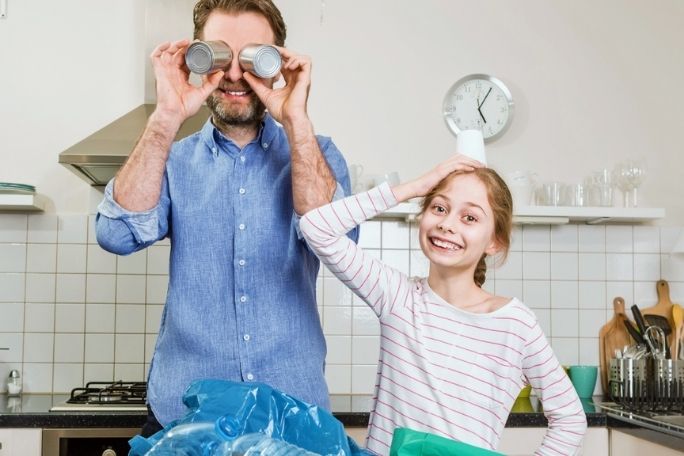Lesson summary
Students are challenged to rethink what is meant by the term ‘waste’. They begin by defining waste and recycling, before categorising items as either landfill, recyclable and/or eligible for the ACT Container Deposit Scheme (CDS). They then explore why recycling is important and are invited to consider how waste can be a valuable resource including how some ‘waste’ items can be exchanged for a 10 cent refund through the ACT CDS. Students then communicate messages around rethinking waste.
Learning intentions:
Students will...
- encourage their community to rethink their approach to ‘waste’ and engage with recycling.
Success criteria:
Students can...
- define key terms around waste and recycling
- think critically about society’s approach to ‘waste'
- communicate messages around waste, recycling and the ACT CDS to an audience.
Lesson guides and printables
Lesson details
Curriculum mapping
Australian Curriculum content descriptions:
Year 3 & 4 Design and Technologies:
- Critique needs or opportunities for designing and explore and test a variety of materials, components, tools and equipment and the techniques needed to produce designed solutions (ACTDEP014)
- Generate, develop, and communicate design ideas and decisions using appropriate technical terms and graphical representation techniques (ACTDEP015)
- Select and use materials, components, tools, equipment and techniques and use safe work practices to make designed solutions (ACTDEP016)
- Evaluate design ideas, processes and solutions based on criteria for success developed with guidance and including care for the environment (ACTDEP017)
Year 4 HASS:
- The use and management of natural resources and waste, and the different views on how to do this sustainably (ACHASSK090)
Syllabus outcomes: ST2-5WT, GE2-2
General capabilities: Critical and Creative Thinking, Ethical understanding.
Cross-curriculum priority: Sustainability
Relevant parts of Year 3 & 4 Design and Technology achievement standards: Students create designed solutions for each of the prescribed technologies contexts. They explain needs or opportunities and evaluate ideas and designed solutions against identified criteria for success, including environmental sustainability considerations. They identify the interconnections between components of the environment and between people and the environment. Students recognise the importance of the environment and identify different possible responses to a geographical challenge.
This lesson is part of the wider unit of work ACT CDS School Resources
Time required: 60 mins
Level of teacher scaffolding: Medium – Facilitate class discussion and support students in their independent work
Resources required
- A range of waste items that vary in colour, weight, shape and texture. These could include some used paper, some newspaper, a small plastic tub, plastic bottle, a milk carton, a paper bag, and some bottle lids. Make sure all items are clean and sharp edges are covered with masking tape.
- Device capable of presenting a video to the class
- Student Worksheet – one copy per student
Skills
This lesson is designed to build students’ competencies in the following skills:
- Communication
- Community engagement
- Creativity
- Problem solving
Additional info
The ACT Container Deposit Scheme (ACT CDS) was introduced by the ACT Government in 2018 as a litter reduction initiative. Participants collect and return their eligible drink containers at an ACT CDS return point for a 10 cent refund on each. For further information about the ACT CDS, please visit actcds.com.au
This lesson plan has been developed by Cool Australia, in collaboration with Exchange for Change, the scheme coordinator for the ACT CDS, as part of a suite of curriculum-linked resources for teachers that support schools’ participation in the scheme and enable teachers to discuss the environmental benefits of the scheme as part of their sustainability lessons.


Welcome back!
Don't have an account yet?
Log in with:
By signing up to Cool.org you consent and agree to Cool's privacy policy to
store, manage and process your personal information. To read more, please see
our privacy policy here(Opens in new tab).
Create your free Cool.org account.
Many of our resources are free, with an option to upgrade to Cool+ for premium content.
Already have an account?
Sign up with:
By signing up to Cool.org you consent and agree to Cool's privacy policy to
store, manage and process your personal information. To read more, please see
our privacy policy here(Opens in new tab).